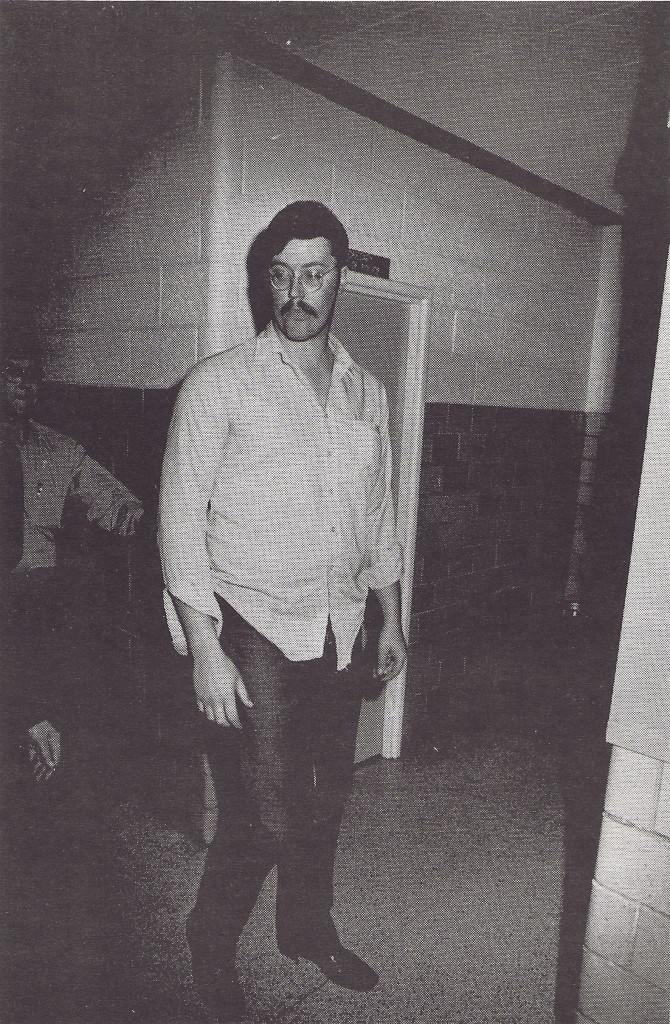Revised from DISGUISE OF SANITY Pepperbox Books © Michael Cartel
Giant Ed Kemper exchanged smiles with a young couple as they passed on a date. Kemper carried a camera bag with the severed head of a girl he just murdered, saying later that the distance he felt between the couple passing and himself was so great he could hear the wheels squeak.
Kemper’s wheels worked well enough for him to kill efficiently since his release from Atascadero State Hospital for the criminally insane the year before.
Born in 1948 with an older and younger sister, Edward E. Kemper III remembered that his parents used to yell a lot. Even when they were not arguing they talked loudly. His very tall parents separated when Ed was four, eventually divorcing within five years. He revered his father and resented living with his mother, but soon learned to escape with his fantasies. His ideas regarding religion, sex and death became blurred and confused very early.
In 1957, Clarnell (Kemper’s mother) took her children from California to Helena, Montana, where she worked as a bank secretary. Ed had a hard time making friends, finding it easier just to withdraw into his daydreams. He learned that his mother didn’t like men in general, and his beloved father in particular. Clarnell told Ed that he was just like his father.

Clarnell was also afraid that if she showed too much affection to her son he might turn out gay like her nephew. But while her attitude with Ed was stern she was never overtly cruel or physically abusive. Ed may well not have been happy under perfect conditions, but he felt betrayed by both of his parents.
He needed to find an outlet to test his overwhelming curiosity with death on someone. He decided that the first victim would be the family cat.
Kemper buried the pet alive in the backyard, then returned to cut off its head and take it to his room to prey over. Ed’s fascination with death found other casualties. His older sister often discovered her several dolls mutilated or beheaded. Later she found the head of another cat in the trash, but Ed asked her not to tell their mother about the incident. When she suspected that her brother might be in puppy love with his second grade teacher, Ed told her that he could not allow feelings of affection for his instructor to reach him because he would have to kill her.
While still young, Kemper thought a lot about murdering people, especially women, with one of the daggers from his impressive knife collection. He killed his mother’s friends in his mind, keeping track of their addresses if they moved, just in case he got a chance at them. Still, it remained part of his fantasy and he would only kill animals at this point. At 13 he shot a neighbor’s pet dog, having already experimented on all of Clarnell’s animals. Then he began entering his mother’s bedroom as she slept, standing over her with a knife. But he wasn’t ready to kill her.
 Clarnell remarried a kind, gentle man who tried to understand Ed, but Kemper only thought of him as another obstacle and wanted to kill him too. Ed believed that if he murdered this new intruder and stole the car, he could rejoin his real father. He stood behind his stepfather with a baseball bat but couldn’t force himself to strike him. Clarnell’s second marriage also ended in divorce, fortunately for the escaping husband.
Clarnell remarried a kind, gentle man who tried to understand Ed, but Kemper only thought of him as another obstacle and wanted to kill him too. Ed believed that if he murdered this new intruder and stole the car, he could rejoin his real father. He stood behind his stepfather with a baseball bat but couldn’t force himself to strike him. Clarnell’s second marriage also ended in divorce, fortunately for the escaping husband.
As a teenager, although tall and powerfully built, Ed thought of himself as clumsy and weak, believing that if he could only live with his dad everything would correct itself. Ed was eventually allowed to stay with his father and stepmother in Los Angeles, but nothing much changed.
The teens at the new junior high school still avoided him. Of course it didn’t help that he sat and stared at people. Particularly distressed was the new Mrs. Kemper. She got migraine headaches every time Ed, now a six-foot-four, husky 15-year old, entered the same room. It was a tough adjustment for everyone and Mr. Kemper had to return his son back to Montana.
Back home, Ed had a pet cat of his own, but while visiting his father the cat became attracted to his sister. Of course this did nothing for Kemper’s self-esteem, especially after getting discarded back to his mother, so he calmly killed the animal. He took a machete from his cutlery collection and carefully chopped off part of its head then stabbed it to death. He wasn’t quite sure what to do next, so he disemboweled it, placing the intestines in a closet and burying the carcass outside in what was now a pet cemetery.
Unable to live with his mother, Ed stole Clarnell’s car and drove back to his father again. Mr. Kemper accommodated his son during Christmas, then took Ed to visit his paternal grandparents at their lavish farm by the Sierra Mountains. Ed realized that the visit was not temporary when he was enrolled in the local school.
To Ed this was just more rejection and betrayal, and he was now forced with relatives that he barely knew. No one loved him, everyone tried to get rid of him. He never considered that he also made things most difficult for people to like about him. Now he could blame his grandparents for keeping him away from his father. And he especially faulted his grandmother for reminding him of his mother, another women who liked to emasculate men. He thought.
Kemper did well at the new school and it appeared that he was adjusting. He came to admire his grandfather who gave him a rife to target shoot. Kemper became good at shooting all the small animals on the farm, and although warned by his grandfather not to aim at the birds, Ed took a shot at everything that flew over the property.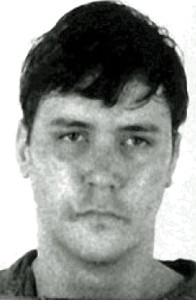
Still fantasizing about killing his mother, he now transferred the fascination of murder against his grandmother. At 66, the senior Mrs. Kemper was a children’s story writer and painter, and often asked Ed his opinions as she wrote her material. But his quiet, intense stare made her at first irritated, and later frightened.
Ed visited his mother and her third husband in Helena, then returned to his grandparents where it was assumed he would stay. Kemper had other plans when he sat at the kitchen table listening to his grandmother correct one of her stories.
Kemper pulled out his rifle, saying he was going to hunt rabbits, then waited by the porch. He looked through the screen door to the back of his grandmother and felt the same kind of relaxed anger he had with his cat. Ed slid the rifle trough the door and fired a round into her head. He fired twice at her back as she lay on the floor and thought about undressing her, but was afraid of what his grandfather might do to him. Kemper pulled her into a bedroom and waited for his grandfather to return from the store. As the old man parked his car, Ed shot him and locked the body in the garage. Ed carefully washed the blood from the floors but wasn’t sure what to do next.
He called up his mother in Montana and explained the situation. She said to call the Madera County Sheriff. Ed did what he was told. waited on the porch for the authorities, calmly identified the bodies, then politely accompanied them to jail.
As a Superior Court hearing to determine Kemper’s state of mind, dissenting psychiatrists on the Kemper report wrote they did not observe any elements of psychosis; flight of ideas, thought interference or hallucinations. Ed was psychopathic, and legally sane. But the prevailing sentiment was that Ed suffered from paranoid schizophrenia and should be treated rather than punished. Edmund Kemper the Third, just shy of his 16th birthday was declared legally insane and ordered to Atascadero State Hospital for treatment.
In 1963, the Community Mental Health Centers Act resulted in mandatory release of disturbed persons who were not considered ‘dangerous.’ The cities, it was reasoned would build lavish halfway houses to accommodate the new inhabitants now dumped into their jurisdictions. The cities, however, were not bound by law to welfare the mentally ill. Many released patients merly drifted into skid row sections or became part of the fringe street crowd.
When Ed Kemper entered Atascadero Hospital in late 1964 there was much debate over the concept of insanity, violence and responsibility. Radicals wanted armed rebellion, social scientists offered moral understanding for individual rage, and penitentiary inmates called themselves political prisoners. Personal culpability was becoming an issue of social justice and outrage rather than a crime or illness. Meanwhile, the sexual revolution was overhauling taboos, no matter how violent or bizarre between consenting, experimenting adults. Abstract ideas of perversion, deviation and judgement were also being reevaluated and overhauled.
Kemper was quite aware of the changing attitudes regarding individual violence, total sexual freedom and the warehousing of mental patients. It was now much easier to get released with the new laws, treatments and progressive attitudes. But a mental patient still had to make progress and appear to be ‘cured,’ and Ed had an incentive to get out. He was appointed in charge of testing other patients, and the staff was most impressed with his diligence, attitude and leadership. He talked articulately and drew sharp conclusions on many subjects. His own intelligence was officially evaluated at near genius.
But Kemper was learning a lot more at the hospital than they knew. He talked to rapists who told him that women were born victims and easy to attack. Many of the sex offenders said they were going to rape more women when released. If a patient was clever he could fool the hospital specialists and the two to four year stay sure beat the 20 to life in the state prison. Kemper’s violent sexual dreams no longer seemed abnormal after reading the new attitudes in sex literature or snuff pornography, and certainly no fantasy he imagined was any stranger than what he heard from other patients. But he also thought it foolish to leave the victims alive after an assault; that’s why the rapists were here in the first place.
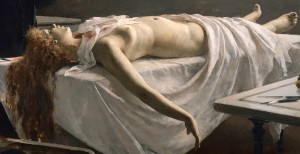 In 1969, after five years in therapy, Ed Kemper got released under the jurisdiction of the California Youth Authority. The psychiatrist in charge did not believe that Ed was ready for release, but the parole board concluded that he had served enough time to be cured. In any case, he had made remarkable intellectual and emotional progress. While many were certain Ed was adjusting, he was dreaming and planning on murder. The same doctor who was against Ed’s freedom made a formal warning to the CYA, telling them that Kemper should NEVER be released to his mother. So naturally, the California Youth Authority released Edmund Kemper, now 20 years old, six-foot-nine and 285 pounds to his mother.
In 1969, after five years in therapy, Ed Kemper got released under the jurisdiction of the California Youth Authority. The psychiatrist in charge did not believe that Ed was ready for release, but the parole board concluded that he had served enough time to be cured. In any case, he had made remarkable intellectual and emotional progress. While many were certain Ed was adjusting, he was dreaming and planning on murder. The same doctor who was against Ed’s freedom made a formal warning to the CYA, telling them that Kemper should NEVER be released to his mother. So naturally, the California Youth Authority released Edmund Kemper, now 20 years old, six-foot-nine and 285 pounds to his mother.
Actually, it was three months before he lived in the same room with Clarnell. At first, Ed stayed nights at a halfway house, but no one seemed to pay much attention. He called his parole officer to find out when he was suppose to report, but was told (according to Kemper) that they were busy and would contact him, sometime. Then Ed got his attorney to petition a judge to order his criminal and metal records sealed.
While Ed was at Atascadero, Clarnell waked into and out of her third marriage. She was now working as an administrator at the new Santa Cruz campus of the University of California. When he finally moved in with his mother, Kemper was convinced that most of his problems came from her. To get away from their constant arguing he spent much time at the Jury Room bar, frequented by many off-duty cops who nicknamed Kemper ‘Big Ed.’
Kemper took a few classes at the local junior college where he easily earned perfect grades but couldn’t get interested in a goal, especially when he looked at the people around him. The world had changed considerably since last viewed; the young men wore their hair long and talked about revolution and drugs. They hated all the representatives of the government, especially the police, and Kemper was appalled. He wanted to be a policeman, just as soon as his past files were sealed.
He particularly disliked the liberated college girls. They were arrogant and fearless, hitchhiking everywhere with much of their skin exposed to tease. the girls would give themselves sexually to anyone, while they looked at Kemper, with his neat appearance and short hair, as if the fault was his. they would have to be taught a lesson.
Ed took a farm labor job in nearby Watsonville, driving around for a while on a motorcycle until he twice wrecked it, the second time breaking his arm. He got his first career setback when he learned that he was too tall to be accepted into the police force. He traded his bike for a regular car, adding on a whiplash antenna and CB radio so that he could at least feel like a real cop. He saved enough money to move from his mother and onto a small apartment near San Francisco. Then he started giving rides to the hitchhiking college girls.
By 1971, he picked up nearly 200 girls, just talking, thinking what it would be like to kill them; what they would look like headless; how it would feel to make love to the corpses.
Kemper learned the techniques of luring females into his car, to appear normal, to keep up a lively conversation. He sat low in the car seat to minimize his enormous size. He knew every off-ramp on the freeways, every side road, every deserted fire road and secret trail. Kemper took off his drooping antenna to look less obvious, changed into dark clothes, then slipped a tube into the passenger door latch, making it impossible to open from the inside. He borrowed a revolver and loaded up his many knives into the car. Kemper finally felt ready to live out his fantasies.
In May of 1972, Ed picked up two 18-year old girls hitching from Berkeley. Kemper drove his practiced loops going east to Livermore, rather than south where the girls wanted to go. Ed talked and laughed with his passengers, the one in the back introduced herself as Anita, and the girl beside him with the huge blue eyes and long dark hair was Mary. Neither of the girls suspected that they were on anything but the road to Stanford, even with the rural surroundings.
But now Ed was nervous. He knew just where to go, everything was ready, he fondled the gun under his seat, but he experienced stage fright. He had to push himself.
He stopped the car at his prearranged spot and aimed the gun at Mary, but she didn’t act surprised. Mary assumed that Ed was merely a rapist and began using all of the dialog and tricks she learned in college to reason with rapists. Anita appreciated the predicament more, but neither girl acted with the appropriate terror that Kemper hoped he would command.
Mary’s personality and stunning eyes were finding their way into Kemper, but he kept his mind of his plans, pulling Anita outside the car. He shut the passenger door while securing Anita into the back trunk. Then Ed’s pulse exploded; he realized that he had locked Mary in and himself out of the car. His revolver was also back under the driver’s seat! Kemper ordered Mary to open the door, and for the one moment that Mary was not in control of herself, she let Kemper in.
He placed Mary on her stomach in the back seat, tying her hands behind with handcuffs. Ed was still more scared than Mary, his mind racing too fast for what he had to do. He tried to strangle Mary with a cord but it got caught over her mouth and snapped. Then he reached for his huge buck knife and probed it into her back, Nothing was like he expected; the knife, razor sharp, wasn’t penetrating the girl deeply enough. He stabbed harder and Mary first sobbed, then cried out for Anita. It was turning into a mess, so Ed took a deep breath and cut Mary’s throat. Then he ran out of the car and unlocked the trunk to kill Anita.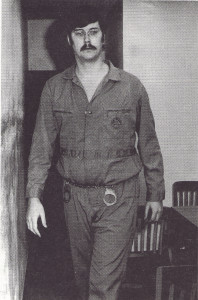
Kemper thought he was every bit as frightened as Anita. His mouth quivered explaining to the girl that he needed help with Mary. Kemper had to get Anita out to more easily murder her, but she pulled further inside the trunk. Ed thrashed with the buck knife, but he could only strike her arms. He cut his own hand, then slashed Anita’s face, and the girl found her voice to scream. Kemper thought he heard other people and fought harder to overcome the mortally wounded girl. Anita was now swinging at imaginary objects as Kemper found the range. He kept stabbing, surprised at the difficulty of killing, not at all like on television. Some fight so hard for their lives.
He slammed the trunk shut, then went to drive off but could not find his keys. Before, Kemper was just excited and scared, but now he panicked. Everything had been planned so well, but like an idiot he lost the keys to a car registered in his name, filled with blood and murdered corpses. He inadvertently checked his comb pocket and found the keys there. Ed never put keys in his back pocket, except this time.
Kemper arrived at his apartment in the early evening, carrying the two dead girls in a blanket to his room. He dissected Mary and decapitated Anita, then took pictures with his Polaroid camera at various stages of mutilation. He had no use for Mary’s expensive camera, since he wouldn’t be able to develop the kinds of prints he took anyway, but kept the camera bag. He also kept several of their personal articles, believing that by possessing their belongings he would keep the girls forever. He was careful to discard the clothing and other items in different trash bags, dropping them in various locations. Later in the week he buried their torsos in the Santa Cruz Mountains, but kept their heads in his room. That is, until they began to age.
Both Mary and Anita came from Affluent families and were students at Fresno State College. Their parents first contacted the Fresno police but were told to wait. Then Mary’s father filed a missing person report in Santa Barbara where he lived, but nothing further was done. The parents retraced where their daughters had been, placed a picture and inquiry in a San Franciso newspaper and eventually hired a private investigator. The girls had vanished completely.
Four months later, Kemper passed a girl who held up a sign indicating she wanted a ride. He went around the block and picked up a 15-year old dance student named Aiko. Ed drove into the mountains and strangled the girl, then raped the corpse. Kemper was no longer nervous about murder. He locked Aiko in his truck, stopped at a bar to drink a few beers, then visited his mother, just to see how relaxed he could be. Back at his apartment he began dismantling the body.
Ed drove out to Fresno to visit two psychiatrists. He needed their consent to legally seal his juvenile records. Kemper’s attorney had already petitioned the Superior Court, and all that compelled a judge were the doctors’ signatures.
Aiko’s mother phoned police in California, Oregon and Washington state, but hit the same stonewall that Mar’s parents ran into. She did what she could printing and placing posters throughout Berkeley. Some said they remember Aiko getting a ride the night she disappeared but couldn’t recall the car or driver. Only when several corpses of young women got discovered in the Santa Cruz area were the missing reports ever taken seriously.
There was another former mental patient, also released too early and also killing hitchhikers in the Santa Cruz vicinity. Herbert Mullin thought that he could prevent earthquakes if he killed people, but unlike Kemper, he dumped the bodies where they could easily be discovered. The Santa Cruz University posted warnings against hitchhiking, or if one had to take a ride, be sure the car had a university decal. Of course Ed had a decal, and the next several girls he picked up happily got into his car.
Kemper never killed a girl if he didn’t feel that everything was ‘right.’ After driving three girls to their destinations, he picked up a tall blonde and felt the conditions were perfect for her death.
Ed had the pistol he just bought (legally) under his seat and relaxed. He was in control. Killing was simple now that he could use a gun. A knife or rope took forever to kill, and a blade made such a mess. Kemper later said that he was never attracted to blood (as were some sexual sadists), that “blood is a pain in the ass.” But now because of his poor income, Kemper had to move back in with his hated mother, so he thought about the actual strategy of getting a body into the house.
The tall blonde introduced herself as Cynthia and Ed drove near Watsonville, petting and brandishing his revolver, happy to see that Cynthia was quite scared. He ordered her into his trunk and calmly fired a bullet into her head. He waited into the evening for his mother to leave for work, then brought the body through the house to his own room. As he had with the other girls, Kemper made love to the corpse before dissecting it, but this time he buried the girl’s head in the back yard; the face pointing to his bedroom so that he could talk to it at night.
Kemper watched the television show Police Story to get ideas on how to avoid detection. He went to the Jury Room bar more frequently to buy cops drinks and ask them how they were progressing on the rash of mutilation murders. All the police at the tavern liked Big Ed a lot; the stories of Kemper’ enormous strength while working in road construction was legendary and made him all the more popular. He was to them a gentle giant and harmless groupie. And he also paid for the drinks.
But all of Kemper’s caution paid off, and all of Herbert Mullin’s carelessness got him caught. Then just after Mullin ws captured, the first of Kemper’s victims was discovered.
A highway patrolman saw an arm and other human remains at the bottom of a cliff. The mangled, headless body was identified as tall blonde Cynthia, missing for less that a day. Kemper was upset that one of his kills had been uncovered after all the trouble.
Kemper’s younger sister was shocked at the huge gun and knife display and asked Ed if he had something to do with Cynthia’s death. Ed was outraged that the girl had such a monstrous thought, swearing that his only hobbies were in the house. He walked her back out to the car, then returned to fondle his pile of body sections, noticing that the specimens were fading and would need to be replaced.
It rained when Big Ed drove around the campus. A girl flagged down Kemper, looking hard to see if he was a homicidal maniac. When she glanced at the ‘A’ sticker on his car she relaxed and hopped in. Kemper cruised the university and stopped for another wet hitchhiker. She entered thinking that the girl in the front seat was the driver’s girlfriend. The two girls talked and laughed, Kemper hearing that the shapely blonde next to him was Rosalind, a psychology student who shared an apartment with four other girls. The beautiful asian girl in the back was Alice, now in her Senior year. He asked the girls if they wouldn’t mind the scenic route to their destinations.
Kemper pretended to admire the rainy view while slowing into a dark road. Quickly he pulled out his gun and shot Rosalind in the head; and Alice knew that with all her caution she was now going to die. Alice looked for a way out but could only find the floor. Kemper kept glancing at the road while trying to aim at Alice. He also had the gun in his unfamiliar right hand, and Alice was clawing herself into the backseat carpet. Kemper fired several times, but could still hear the girl breathing heavily with a haunting moan. He stopped at another road and shot Alive evenly in the head. Kemper loaded the bodies in the trunk and returned to his mother’s house.
On February 8, the Santa Cruz campus held a memorial service for Alice and Rosalind, with much of the city attending. A few days later their dismembered bodies were found in Alameda, their heads later discovered south of the Bay. The only hitchhikers now around the university were men, and Big Ed now thought seriously about killing his mother.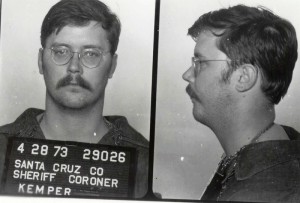
Clarnell went to a party on Friday Easter weekend, coming home at four in the morning a bit intoxicated. Kemper entered her room and they argued (but every time they talked it was an argument). Ed just went back to his bedroom to wait for Clarnell to fall asleep. An hour later he raised a hammer over his mother’s head and struck her. He wanted her to die as painlessly as possible. She was still alive but unconscious as Kemper cut her throat, then continued cutting until her head was removed. He slept with the headless corpse the rest of the night, then mutilated the body next day. Kemper tore out the larynx and ground it into the garbage disposal to humiliate his mother’s verbal weapon. He put the head on a mantel, shouting at it, then threw darts.
That afternoon Kemper called his mother’s friend, Sara Hallet to come by the house for dinner. He sat a rifle near the door, had handcuffs in his pocket, masking tape nearby. Sara entered, Ed smiling, told her that Clarnell is waiting, then hit her in the stomach. Hallet was already dead as he lifted her off the ground under one arm. He achieved a sexual climax while choking her, then continued strangling the dead woman on the floor.
Kemper took Hallet’s car and drove east. He picked up two hitchhiking girls but merely dropped them off unharmed. In Nevada he rented another car, carefully transferring his precious guns and knives. He drove nonstop into Colorado, surviving on caffeine pills, and was ticketed once for speeding. Kemper waited to hear about the manhunt against him but was disappointed that there was nothing on the news.
Delirious from lack of sleep, he called the Santa Cruz police from Pueblo and confessed to his mother’s murder. Kemper kept calling back, each time paying for the call until detectives could verify his story. Colorado police were notified and Big Ed informed the Santa Cruz desk officer that everything was under control since he was now surrounded in his phone booth by armed men.
California detectives flew into Colorado to question Kemper. He explained everything on tape, enjoying the expressions on the cops when detailing his decapitations, necrophilia and cannibalism. The prosecution now had a legal and complete confession and all Kemper’s attorney could do when taking over the case was to claim insanity for their client.
Certainly no one in his correct mind could have behaved like Kemper. The defense, however, could not locate a psychiatrist to testify for them. The political and public outrage against California’s mental hospital policies made it tough for any jury to send Kemper back through that revolving door. All were scared that he would just get ‘cured’ again then get released again.
The doctors at Atascadero were shocked that Ed never called anyone when he first got the urge to kill after release. No psychiatrist wanted to be in a position of predicting the future violent behavior of any patient, but the law made them regularly decide who was to be released. And Kemper at the time was a model patient like no other.
Of all released patients at Atascadero (or any comparable facility), one of every four would commit again his original crime; child molesting, rape, or sex murder.
The prosecution had plenty of psychiatrists to testify for their case. The court appointed doctor, Joel Fort, 20 years a criminal psychiatrist, spent several days with Kemper. He listened and studied (with other doctors) the tapes, checked Kemper’s history against his statements, and watched Ed while under the effects of sodium amytal. Dr. Fort said that Kemper was more obsessed with sex than anyone he had ever observed. He did not have hallucinations, he was not schizophrenic. He knew right from wrong. He carefully planned out the murders while covering up his crimes. Kemper was legally sane.
Before the trial began, Kemper tried to slash his wrists with a writing pen given to him by a reporter, then fought to keep medical attention from himself. Finally subdued with Mace and bandaged for his appearance in court, the spectators listened to Kemper’s taped confession. Like a proud parent bragging about his child’s accomplishments, Kemper’s police interview told of each event, location and grisly particular regarding the murders. As with nearly all trials involving female multicide killers, the front rows were filled with young, attractive women, some becoming romantically attached to the defendant.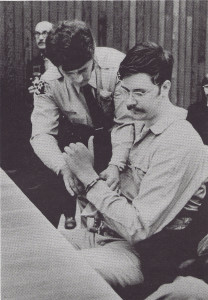
From a trial that took three weeks, the jury in five hours voted that Kemper was sane and guilty on all eight counts. Kemper asked to be executed but the California death penalty was reinstated just after Ed’s conviction, and saved him from the gas chamber. Kemper was sent to Folsome prison (later to California Medial Facility in Vacaville) to serve a life term, or until a parole board would allow him back out. Before being transferred, Kemper had to endure Herbert Mullin, the other local multiple killer scream and shout at all hours in an adjoining cell.
Kemper insists that he no longer feels hostility toward women now that his mother is deceased. But few people care if he is sick or cured, punished or repentant. What they care about is that he just stay in prison.
Disguise of Sanity 1985, booklength nonfiction. Revised/updated 2016 third edition
NOW on KINDLE AMAZON
CLICK ON: DISGUISE of SANITY on KINDLE

Disguise of Sanity 1985, booklength nonfiction. Revised/updated third edition ©Michael Cartel

